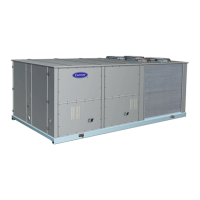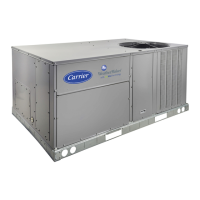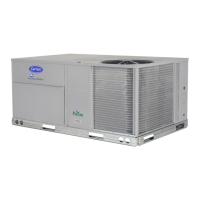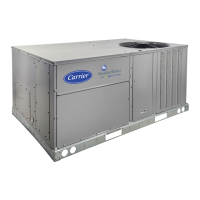50
Failure Mode Operation
If either of the SCT sensors has failed, then the control defaults to
control based on the OAT sensor and turns on CD.F.B when the
ambient is above 65°F and off when the ambient temperature is
below 50°F. If the SCT and OAT sensors have all failed then the
control turns on CD.F.B when compressors are on.
ECONOMIZER INTEGRATION WITH MECHANICAL
COOLING
When the economizer is able to provide free cooling (Run Status
ECON
ACTV = YES), mechanical cooling may be delayed
or even held off indefinitely.
NOTE: Once mechanical cooling has started, this delay logic is no
longer relevant.
Configuration
COOL
M.M. (Motormaster Control) for
Factory-Installed Motormaster Option Unit
If the unit is equipped with the factory-installed Motormaster V
control, the Motormaster installed configuration (Configuration
COOL
M.M.) must be set to YES, if the unit size (SIZE) =
60 tons. This is because “Condenser fan relay A” must be ener-
gized to enable Motormaster V control, and the 60 ton offers 3
stages of head pressure control in the case where “Condenser fan
relay A” may be requested off during head pressure control oper-
ation. By configuring M.M to “YES”, the control would be in-
structed not to turn off the relay to attempt 3 stages of head pres-
sure control.
Economizer Mechanical Cooling Delay
This type of mechanical cooling delay is relevant to the all ma-
chine control types.
If the economizer is able to provide free cooling at the start of a
cooling session, the mechanical cooling algorithm checks the
economizer’s current position (Run Status
ECON
ECN.P) and compares it to the economizer’s maximum position
(Configuration
ECON
EC.MX) – 5%. Once the econo-
mizer has opened beyond this point a 2.5-minute timer starts. If
the economizer stays beyond this point for 2.5 minutes continu-
ously, the mechanical cooling algorithm is allowed to start com-
puting demand and stage compressors.
Economizer Control Point (Run Status
VIEW
EC.C.P)
There are 4 different ways to determine the economizer control
point when the economizer is able to provide free cooling:
• If no mechanical cooling is active and HVAC mode = LOW
COOL
EC.C.P = Setpoints
SA.LO + Inputs
RSET
SA.S.R
• If no mechanical cooling is active and HVAC mode =
HIGH COOL
EC.C.P = Setpoints
SA.HI + Inputs
RSET
SA.S.R
• When the first stage of mechanical cooling has started
EC.C.P = 53°F plus any economizer suction pressure reset
applied
• When the second stage of mechanical cooling has started
EC.C.P = 48°F plus any economizer suction pressure reset
applied
Heating Control
The A Series ComfortLink control system offers control for 3
different types of heating systems to satisfy general space heat-
ing requirements: 2-stage gas heat, 2-stage electric heat and
multiple-stage (staged) gas heat.
Variable air volume (VAV) type applications (C.TYP = 1, 2, 3,
or 5) require that the space terminal positions be commanded
to open to Minimum Heating positions when gas or electric
heat systems are active, to provide for the unit heating system’s
Minimum Heating Airflow rate.
For VAV applications, the heat interlock relay (HIR) function
provides the switching of a control signal intended for use by
the VAV terminals. This signal must be used to command the
terminals to open to their Heating Open positions. The HIR is
energized whenever the Heating mode is active, an IAQ pre-
occupied force is active, or if fire smoke modes, pressurization,
or smoke purge modes are active.
SETTING UP THE SYSTEM
The heating configurations are located at the local display un-
der Configuration
HEAT. See Table 49.
Heating Control Type (HT.CF)
The heating control types available are selected with this variable.
0 = No Heat
1 = Electric Heat
2 = 2 Stage Gas Heat
3 = Staged Gas Heat
Heating Supply Air Setpoint (HT.SP)
In a low heat mode for staged gas heat, this is the supply air
setpoint for heating.
Occupied Heating Enable (OC.EN)
This configuration only applies when the unit’s control type (Con-
figuration
UNIT
C.TYP) is configured for 1 (VAV-RAT) or
2 (VAV-SPT). If the user wants to have the capability of perform-
ing heating throughout the entire occupied period, then this con-
figuration needs to be set to “YES.” Most installations do not re-
quire this capability, and if heating is installed, it is used to heat the
building in the morning. In this case set OC.EN to “NO.”
NOTE: This unit does not support simultaneous heating and cool-
ing. If significant simultaneous heating and cooling demand is ex-
pected, it may be necessary to provide additional heating or cool-
ing equipment and a control system to provide occupants with
proper comfort.
MBB Sensor Heat Relocate (LAT.M)
This option allows the user additional performance benefit when
under CCN Linkage for the 2-stage electric and gas heating
types. As two-stage heating types do not “modulate” to a supply
air setpoint, no leaving air thermistor is required and none is pro-
vided. The evaporator discharge thermistor, which is initially in-
stalled upstream of the heater, can be repositioned downstream
and the control can expect to sense this heat. While the control
does not need this to energize stages of heat, the control can wait
for a sufficient temperature rise before announcing a heating
mode to a CCN linkage system (ComfortID™). For units with
Humidi-MiZer option: either 1 or 4 thermistors can be reposi-
tioned downstream.
If the sensor is relocated, the user will now have the capability
to view the leaving-air temperature at all times at Tempera-
tures
AIR.T
CTRL
LAT.
NOTE: If the user does not relocate this sensor for the 2-stage
electric or gas heating types and is connected with CCN Linkage,
then the control will send a heating mode (if present) uncondition-
ally to the linkage coordinator in the CCN zoning system regard-
less of the leaving-air temperature.

